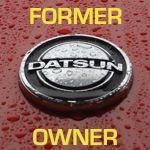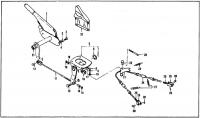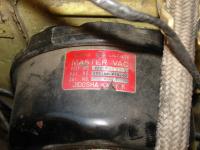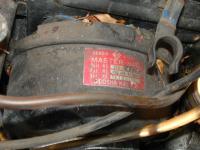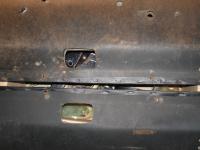Everything posted by Arne
-
Door Lock problems...or are these normal?
Umm, no. That's not right. You have two separate problems, different for each door. On the passenger door, it sounds to me as thought the lock tumblers are jammed. On the driver's door, I'm betting there is a broken or disconnected spring in the lock/latch mechanism.
-
E-brake cable hangers?
I'm not certain those are original. the parts CD shows springs for all 240/260/280Z. I'm certain that my '71 doesn't have anything like that, I just changed the cable a few months ago.
-
E-brake cable hangers?
Huh? What year car? My '71 uses small springs, not rubber. The parts CD seems to agree, for all non-ZX cars. See number 27 in the picture attached.
-
Manual fuel pump filter
I'm running an electric pump currently, and it is the same way. So I think that is normal.
-
Original interiors of series 1 cars
The pictures aren't clear, even at full 7.2 mega-pixel resolution. I'll try to remember to look at them in the daylight some time soon. Prod me if you don't hear back in a few days.
-
Original interiors of series 1 cars
Keith, if you can live with something not exactly original, using later ball joints with the steering knuckles from a later car will bolt right in, and be visually indistinguishable from stock - unless they disassemble the car to check. The knuckles from my parts car went to a7dz for that exact reason.
-
Original interiors of series 1 cars
-
Any interest? Matched set steel wheels, 4/71 date?
No worries, Bryan. I've got plenty of wheels. I was just being lazy. I'll clean up my odd wheel. And thanks for the offer, but I prefer to to have you guys up north owe me. Someday I'll need something important. The date code is stamped into the face of the wheel, following the manufacturer's name (Topy). The wheel in the linked picture is a 4/71. http://classiczcars.com/forums/attachment.php?attachmentid=12497&d=1148696800
-
Original interiors of series 1 cars
I remembered this thread while stripping my parts car this weekend. You may recall that my Series 1 car (10/70, #12746) had the screws in the door panels. Turns out my parts car (4/71, #27602) does not.Well, I have some of the panels off, and took the attached picture. The upper panel is the left panel from the Series 1 car, the lower is from the later car. Note that the Series 1 panel lacks the holes in the back-board for the metal clips. This seems to indicate that the screws WERE original to #12746.
-
My $35 wheels
If you blast them, you'll have to sand the surface to smooth it back out for polishing. Blasting them would be fine in between the spokes, but not so hot on the polished areas. I'd lean toward an acid dip, myself. That should clean them up without totally ruining the smooth areas. They will still need to be re-polished, of course.
-
carb adjustment
I've got 10W-30 in mine, but only because I haven't made it out to the motorcycle shop to get 20 wt. I can confirm that ATF doesn't work all that well, as I tried that before changing to the 10W-30.
-
My $35 wheels
I'd love to find a set of those for my car. Even the narrower 6" wide would be OK for me. Got to keep looking.
-
Need a Mech to install carbs and get the Z running
1.) You can use any of the manifolds, but you need to watch for water passage mis-matches. Your flat-tops and the 3-screw round-tops from a '72 all had water passages in the base of the carbs. The 4-screw round-tops from '70-71 did not have water in the carb bases, just in the manifolds. 2.) There are no real performance reasons to pick one version of round-top over another. Assuming they are in equal condition (look for sloppy throttle shafts, non-sticky pistons and smooth nozzle movement), I'd go with whichever set give the easier installation. If one set has the water passages, you can stay with your existing manifolds, which makes it a simple swap. On the other hand, if you have matched round-tops still on their original manifolds, that might be the cleaner and simpler install. 3.) No idea here, I've only been to DC once, didn't meet any mechanics. 4.) I doubt you'll have much luck finding a school who wants to do it - they study injection these days.
-
Any interest? Matched set steel wheels, 4/71 date?
Because wider rims don't fit in the spare well. I've got a 5 1/2" wide slot mag in the spare well right now, and the spare cover sits 3/4" above the floor. Can't use wider than a 5" in the spare well of a 240.
-
Any interest? Matched set steel wheels, 4/71 date?
I'm just fussy that way, I guess. Can't see putting it in the car if it's all ratty-looking. If I'm going to clean it up at all, I may as well do it right. Not likely that I'd spend much on date-matched wheels for a car that no longer has it's original engine or transmission. I certainly understand the reason some people might want things like that, but my car can never be original again, so why bother?
-
Hello there. 240z info/question
DOH! Man do I feel silly. I guess I haven't really looked at a 280 in a while. I went back and edited out my rather mis-leading comments above.But I say again, the steering wheel is not really important. It looks like a good car for the money.
-
Hello there. 240z info/question
Edit - Rather lame un-informed remarks edited out.But again, the steering wheel is of interest to us as a curiosity, certainly not an issue on whether or not to buy this particular car.
-
Any interest? Matched set steel wheels, 4/71 date?
Here's the deal. I've got a total of 5 stock 4 1/2" steel wheels, four from one car and one from the spare of my parts car. The matched set are date-coded 4-71, the odd one is 3-71. I need to make one of the five a spare for my normal car. I could use the odd one, but it's going to take a fair amount of prep work (strip and re-paint). Or I could use one of the others that is ready to go, but that would break up the matched set. Now, remember that none of these wheels are the proper date code for my car, they are all 6-8 months too late. So it really doesn't matter to me which one I use in the spare. But if someone else might someday need/want the matched set, that would probably be enough reason for me to expend the effort to strip the odd one, rather than break up the set. I'm just not certain if there's enough people truly restoring cars of the 4/71-6/71 vintage to make the set desirable. Does this make any sense to anyone? Should I be concerned about breaking up the set?
-
Hello there. 240z info/question
Definitely not the correct steering wheel. A car with that production date would have had the steering wheel with the holes in the spokes, not the one with the indentations. But you know what? That is totally a non-issue. The proper steering wheels (should you decide to go that way) are easy to find. Shoot, I've got one off my parts car in the garage right now. And so do plenty of other people. A bigger issue is the non-original color, but that can be corrected as well. The short version is that while you can probably expect to find a little rust hidden in that car when you really get into it (there's virtually no such thing as a TOTALLY rust-free early 240Z), for $700 that is a darn good start. Of course, you'll need to add several hundred more to get it transported across the country, but it's probably still well worth it.
-
Tokico HP - Z is two inches taller
Gary, I haven't yet calculated how much to cut, partly because I don't yet know what my end goal is. Something like what Carl suggested, I suspect, though. I've cut springs in the past, and have always been able to figure out how much to cut, I've yet to ruin a set of springs. (Insert sound of Arne knocking on wood.) I'll keep you in the loop, you and I will want to discuss this later, before you do your springs (if you decide to use them).
-
switch in glove box???
The antenna switch was originally mounted on the radio faceplate. Yours waas probably re-located when the radio was changed at some point.
-
Tokico HP - Z is two inches taller
Probably a bit more than 1/4", Carl, when you consider that the 205/60-14s on my car now are a full inch smaller in overall diameter than the stock sizes. So in reality, my car is probably sitting closer to 3/4" higher than the stock US specs.All in all, I'm not certain just why this should be the case, considering that everything all checks out the way it should, and I don't have gas pressure struts polluting the data. I do suspect that when I have them out of the car next time (when I replace the struts) that I'll cut them down some. Just how much depends on whether I use gas KYBs or hydraulic Konis. I'll keep you posted.
-
240Z/260Z/280Z auto to 4/5 speed swap
Since I now have a second 240Z that is a manual transmission car (a later '71 that I'm parting out), I have had a chance to learn a bit more about the differences, other than what I mentioned in the original article. As is the case with the original article, the details here are based on early 240Zs. Some of this will likely apply to later cars as well, but YMMV. Bodyshell - I have found a few other differences in the bodyshell, in addition to the presence of (or lack thereof) the bracket for the clutch hose on the framerail. One is a mounting point on the inside of the firewall above the throttle pedal for the "kickdown" switch. (More on the switch itself later.) Manual transmission cars do not appear to have this mounting tab. But the manual transmission cars do have a rectangular clutch pedal stop (about an inch high) on the firewall, that is missing on some or all automatic cars. Also, the automatic cars have four holes with captive nuts at the four corners of the shift lever opening (to retain the automatic shift selector) that the manual cars don't have. Wiring - Both the engine compartment and dash harnesses are different for the automatics, the rear body harness is the same. The dash harness has extra leads for the "kickdown" switch, as well as an extra dash illumination bulb for the shift selector. In the engine compartment harness, the lead from the ignition switch to the starter solenoid is routed through a neutral safety switch on the automatic before it gets to the starter. (These are the leads that must be connected together.) The reverse light switch leads may have different connectors than on a manual car. And lastly, there is an extra relay on the left inner fender in front of the coil and near the radiator support. More on this below. Mechanical - Under the hood, the automatics all had a radiator with integral transmission cooler in the lower tank. The fittings can be ignored or capped off when the manual transmission is installed. (In fact, these days many aftermarket replacement radiators on the market are fitted with the cooler so that they can be sold as one-size-fits-all.) There is also an extra vacuum fitting on the balance tube, that goes to the transmission modulator. This port will need to be plugged or capped off. And then there is the ignition. The automatics came with a dual point distributor, instead of the single point unit on the manual transmission cars. And this is where a whole lot of the differences are related. You see, the dual point unit was not designed for performance or reliability, it was designed to give more ability to vary the timing advance curve. Under normal driving, one set of points would be used. Under full throttle, the above-mentioned "kickdown" switch (which actually has absolutely nothing to do with transmission kickdown) energizes the relay near the coil, which switches the ignition to the second set of points. That second set has a slightly different static timing, which effectively changed the advance curve. This could cause problems during ignition swaps, if not taken into account. It might be considered less than optimal for the ignition to cut out whenever the throttle was opened wide, which could happen if the ignition were re-wired incorrectly!
-
Tokico HP - Z is two inches taller
OK, final measurements. All four Euro Stage 1 springs are installed, the shocks are NOT gas-charged, tires are 205/60-14 and the car has been driven 8-10 miles since the installation, so they should be as settled as they will get. Before - height at the jack points was LF 7.25", RF 7.25", LR 7.25" and RR 7.0" I did not take any installed height measurements before I started, sorry. After - also at jack points, All four at 8.25". Installed height in the rear is very close to what you noted above, Carl, at about 9". But it's about 8" up front, which seems a bit much compared to your specs listed above - actually close to what the stock US springs should be. I forgot to measure the free length of the old springs until it was too late for the first three. (The old springs got moved straight to my parts car, whose Eibachs are about to close on eBay.) But I did remember in time to measure the old RR spring - it was 14.25" or .75" shorter than it should have been. I'm willing to bet (based on the before measurements) that the other three were probably all about .5" shorter than spec. So the end result is that the car sits considerably taller than it did before on it's well-worn original springs. The ride is moderately firm, but not harsh. When I change shocks later, I may cut them a bit (especially the front) to tune it some, but all in all, I'm happy with them.
-
carb adjustment
NO! Everyone just passes by the REAL first step. Verify and set the float level in each float bowl! If the float level is wrong, any other "starting point" is worthless. ALWAYS set the float level first!




